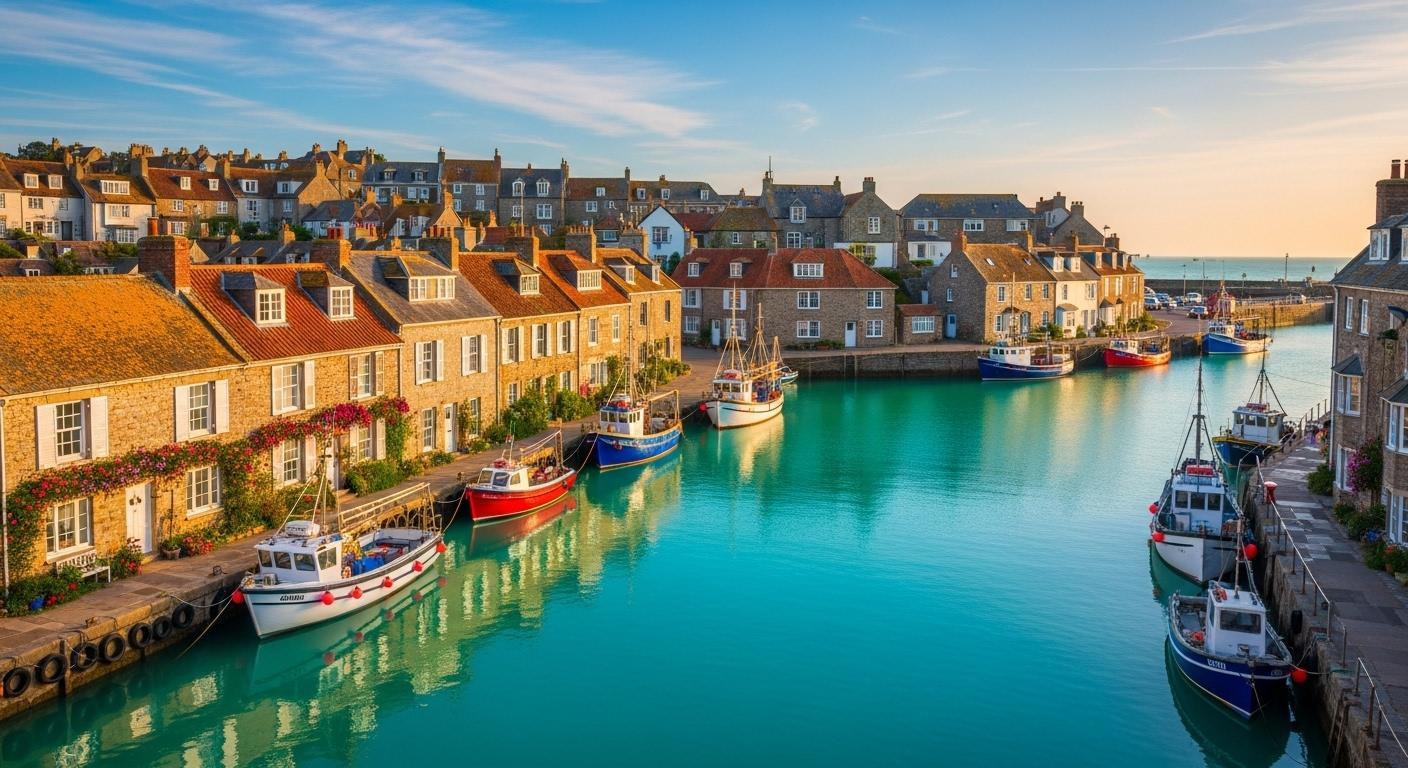Steam rises from morning coffee as fishermen prepare their boats in Barfleur’s harbor at 7:45 AM. Grey granite walls catch the first light while seagulls circle above red-tiled roofs. This isn’t another crowded Norman port drawing millions like Mont-Saint-Michel 56 miles south. This is France’s most overlooked maritime village. Only 545 permanent residents call this 0.23-square-mile coastal gem home. The granite architecture creates a luminous quality that transforms with each tide and season.
Where granite meets the English Channel
Barfleur sits on the northeast tip of the Cotentin Peninsula in Normandy. The village perches at sea level where turquoise Channel waters meet weathered granite quays. From Paris, it’s 218 miles and 4.5 hours by car via A13 and D901 coastal roads.
Cherbourg lies 17 miles south. The nearest airport is Paris CDG, requiring a 3.5-hour train to Cherbourg plus 30-minute drive. GPS coordinates 49.657°N, -1.233°W place you at France’s northern maritime frontier.
Parking proves scarce during peak seasons. Arrive before 9 AM for the best spots. November temperatures hover around 50°F with mild oceanic breezes. The village maintains similar golden-hour magic to Provence’s hilltown gems, but with Atlantic authenticity instead of Mediterranean crowds.
The granite village that time preserved
Architecture built to last 900 years
Local grey granite defines every facade. Quarried from Cotentin bedrock, these blocks withstand Atlantic storms that would crumble lesser materials. White shutters punctuate grey stone walls while red terracotta roofs cap flower-covered cottages.
Saint-Nicholas Church rises fortress-like above the harbor. Its 17th-century square tower stays visible from miles offshore. Inside, stained-glass windows honor sailors’ patron saint. Thick walls and small windows reflect Normandy’s functional beauty philosophy.
1066 and maritime heritage
A bronze medallion on harbor rocks marks where Norman fleets departed for England’s conquest in 1066. William the Conqueror’s ships launched from these same granite quays. In 1120, the White Ship disaster one mile northeast drowned Henry I’s heir, triggering England’s succession crisis known as The Anarchy.
The Plus Beaux Villages de France designation protects this heritage. Unlike touristy Honfleur with its timber facades, Barfleur maintains working port authenticity. Family businesses continue traditions spanning centuries, just like medieval streets elsewhere in France.
What the harbor reveals at dawn
The morning fishing ritual
Three hours before tour buses arrive, fishermen prepare boats in silence. Sea air mingles with coffee aromas from harbor cafés. Colorful boats in reds, blues, and yellows contrast the grey granite quays.
Fishing nets pile in vibrant tangles while turquoise water reflects white shutters. Seagulls circle red roofs as daily rhythms continue unchanged for centuries. Walk cobbled lanes to discover flower-covered cottages with glimpses of the sea.
Nearby Gatteville Lighthouse stands 233 feet tall with 365 steps to climb. Built from 1829-1835, it offers panoramic coastline views. Similar early-morning maritime traditions exist across coastal villages, but Barfleur’s granite setting makes it uniquely Norman.
Fresh seafood on granite tables
Local restaurants serve oysters from Saint-Vaast-la-Hougue 4 miles away. English Channel waters provide mussels, scallops, and sole. Mid-range meals cost $24-40 with seafood priced higher but worth the investment.
Normandy specialties include camembert cheese, apple cider, and calvados apple brandy. The annual Village des Antiquaires fair in August draws collectors but maintains low-key charm. Artisan shops focus on maritime crafts and nautical décor rather than tourist trinkets.
The light that changes everything
At 5:15 PM, low November sun transforms grey granite into glowing amber stone. Mineral deposits in ancient walls activate under golden light. For 45 minutes, the village literally shines through geological magic, not Instagram filters.
While Mont-Saint-Michel draws 3 million annual visitors with commercialized crowds, Barfleur’s 545 residents maintain quiet authenticity. The granite, the harbor, the light, the silence create Normandy before social media discovered it. This maritime heritage lives in daily rhythms, not tourist performances.
Your questions about Barfleur answered
When should I visit and what does it cost?
Spring (March-May) and early autumn (September-November) mornings offer pleasant 46-59°F weather with fewer crowds. Golden light on granite peaks during these seasons. Summer stays mild but brings peak tourists.
Accommodation ranges $60-90 for guesthouses, $100-155 for small hotels. Rental cars cost $50-80 daily from Cherbourg. Gatteville Lighthouse tickets cost $6-8. Boat trips run $28-110 depending on duration. November costs drop 30% below summer peaks.
What makes Barfleur different from other Norman villages?
The working harbor maintains authentic fishing traditions versus commercialized tourist ports. Only 545 permanent residents preserve local lifestyle without second-home invasion. Granite architecture creates unique luminous quality unlike Brittany’s colorful facades.
The Plus Beaux Villages designation protects heritage while 1066 Norman Conquest and 1120 White Ship connections provide unique historical depth. Under 50,000 annual visitors contrast sharply with millions at nearby Mont-Saint-Michel. Proximity to UNESCO Vauban fortifications at Saint-Vaast-la-Hougue adds cultural richness.
How does Barfleur compare to Maine’s coastal villages?
Similar working harbor authenticity exists in places like Rockland, Maine. Both resist over-commercialization while preserving maritime heritage. Barfleur offers 900+ years of Norman history including 1066 invasion sites and 17th-century fortress churches.
Costs run slightly lower than Maine coastal towns. Rooms average $60-155 versus $100-220 in comparable New England villages. Accessibility proves more challenging with Barfleur sitting 218 miles from Paris versus Maine’s proximity to Boston. The granite architecture and English Channel setting provide distinctly European coastal character.
The last seagull circles Gatteville Lighthouse as November dusk turns granite purple-grey. Harbor water stills to mirror glass reflecting white shutters and red roofs. Three fishing boats prepare for tomorrow’s dawn ritual. In Barfleur, maritime Normandy breathes in every granite stone and morning tide.
